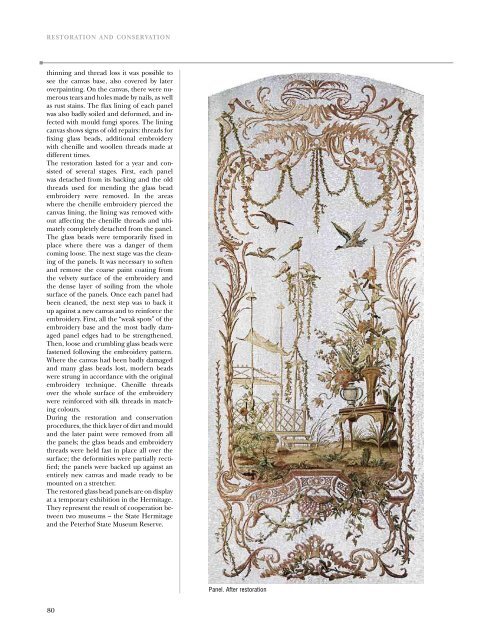The STaTe hermiTage muSeum annual reporT
The STaTe hermiTage muSeum annual reporT
The STaTe hermiTage muSeum annual reporT
Create successful ePaper yourself
Turn your PDF publications into a flip-book with our unique Google optimized e-Paper software.
estoratIon anD conserVatIon restoratIon anD conserVatIon<br />
thinning and thread loss it was possible to<br />
see the canvas base, also covered by later<br />
overpainting. On the canvas, there were numerous<br />
tears and holes made by nails, as well<br />
as rust stains. <strong>The</strong> flax lining of each panel<br />
was also badly soiled and deformed, and infected<br />
with mould fungi spores. <strong>The</strong> lining<br />
canvas shows signs of old repairs: threads for<br />
fixing glass beads, additional embroidery<br />
with chenille and woollen threads made at<br />
different times.<br />
<strong>The</strong> restoration lasted for a year and consisted<br />
of several stages. First, each panel<br />
was detached from its backing and the old<br />
threads used for mending the glass bead<br />
embroidery were removed. In the areas<br />
where the chenille embroidery pierced the<br />
canvas lining, the lining was removed without<br />
affecting the chenille threads and ultimately<br />
completely detached from the panel.<br />
<strong>The</strong> glass beads were temporarily fixed in<br />
place where there was a danger of them<br />
coming loose. <strong>The</strong> next stage was the cleaning<br />
of the panels. It was necessary to soften<br />
and remove the coarse paint coating from<br />
the velvety surface of the embroidery and<br />
the dense layer of soiling from the whole<br />
surface of the panels. Once each panel had<br />
been cleaned, the next step was to back it<br />
up against a new canvas and to reinforce the<br />
embroidery. First, all the “weak spots” of the<br />
embroidery base and the most badly damaged<br />
panel edges had to be strengthened.<br />
<strong>The</strong>n, loose and crumbling glass beads were<br />
fastened following the embroidery pattern.<br />
Where the canvas had been badly damaged<br />
and many glass beads lost, modern beads<br />
were strung in accordance with the original<br />
embroidery technique. Chenille threads<br />
over the whole surface of the embroidery<br />
were reinforced with silk threads in matching<br />
colours.<br />
During the restoration and conservation<br />
procedures, the thick layer of dirt and mould<br />
and the later paint were removed from all<br />
the panels; the glass beads and embroidery<br />
threads were held fast in place all over the<br />
surface; the deformities were partially rectified;<br />
the panels were backed up against an<br />
entirely new canvas and made ready to be<br />
mounted on a stretcher.<br />
<strong>The</strong> restored glass bead panels are on display<br />
at a temporary exhibition in the Hermitage.<br />
<strong>The</strong>y represent the result of cooperation between<br />
two museums – the State Hermitage<br />
and the Peterhof State Museum Reserve.<br />
Panel. After restoration<br />
laBoraTory for ScienTific<br />
reSToraTion of preciouS<br />
meTalS<br />
Headed by I. Malkiel<br />
<strong>The</strong> hoard of mrS. liKhachyova<br />
Restored by I. Malkiel<br />
In May 1978, a precious hoard was found<br />
at the Voskhod Factory in Leningrad. It was<br />
later given to the Department of the History<br />
of Russian Culture at the State Hermitage.<br />
<strong>The</strong> items in the hoard, which date back to<br />
1824–1910, were made by the best craftsmen<br />
and companies in St. Petersburg and Moscow.<br />
Before they were stashed away, all the<br />
objects had been meticulously polished and<br />
packed. <strong>The</strong>re was a date – March 1917 –<br />
on one of the newspapers used for wrapping<br />
them, which provides a terminus ante quem<br />
date for the hiding of the hoard.<br />
<strong>The</strong> restoration of the pieces began in<br />
March 2008. <strong>The</strong> work was hampered by<br />
soil corrosion, since all the objects had been<br />
wrapped in newspapers and hidden under<br />
floorboards. Besides, gilded silver tends to<br />
darken with time because of the porous<br />
structure of the gilding and the diffusion<br />
of the silver itself. <strong>The</strong> copper component<br />
of silver alloys and solders had oxidized, so<br />
that the objects, coated in a green oxide<br />
layer, had fallen apart where they had been<br />
soldered together. Soil corrosion and other<br />
hostile factors turned “new metal” into “archaeological<br />
metal”. Some of the objects<br />
in the hoard (knives, spatulas etc.) were<br />
made of a combination of silver, bone, and<br />
iron, with iron being the most susceptible<br />
Coffee pot. Before and after restoration<br />
Items from Mrs. Likhachyova’s hoard. Before restoration<br />
Items from Mrs. Likhachyova’s hoard. After restoration<br />
to changes in outside conditions. After the<br />
hoard had been extracted, the condition<br />
of the iron objects deteriorated rapidly: the<br />
changed humidity and the access of oxygen<br />
to the dilapidated metal caused a rapid attack<br />
of corrosion. In order to preserve the<br />
iron details of the knives, spatulas and pins,<br />
it was necessary to cover them with a special<br />
anti-corrosive solution. Nearly all the<br />
iron objects were oxidized and covered with<br />
a corroded crust, while iron pins fell apart.<br />
Laser cleaning of works of art has now become<br />
a familiar technique; it is successfully<br />
used by restorers all over the world,<br />
who have by now accumulated considerable<br />
experience of using laser technology<br />
for cleaning metal objects. While the laser<br />
cleaning of metals is still in its early stages,<br />
laser welding has long been a key technique<br />
used by restorers in many of the world’s museums.<br />
State-of-the-art laser technologies<br />
make it possible to restore unique metal artefacts.<br />
<strong>The</strong> Hermitage was the first museum<br />
in Russia to use the latest generation of laser<br />
welding tools in its restoration practice, in<br />
compliance with all the requirements of museum<br />
work.<br />
This work was interesting not only as a treatment<br />
of a whole set of precious objects with<br />
a high artistic, historical and social value,<br />
but also as a major restoration project. After<br />
the end of the procedures, which took<br />
two and a half years, all the objects were displayed<br />
to the public.<br />
80 81




